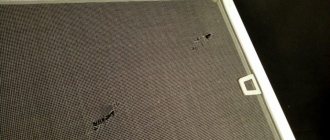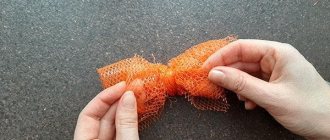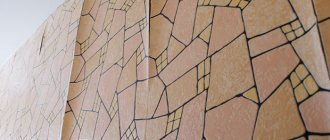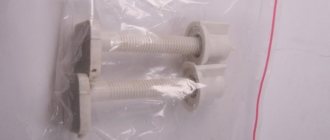As a rule, mosquitoes are ordered immediately when purchasing a window with a metal-plastic profile. However, quite often the user receives a window without a grid - for example, in a new building, where the windows are already installed and no additions are provided for them. The same applies to buying an apartment or house. Often it is necessary to replace failed products. And in all cases, it is very important to know the exact dimensions of mosquito nets for plastic windows to order or purchase finished products.
Let's try to figure out how to take measurements correctly and whether in some cases it is possible to neglect them and rely on standard data.
How to measure the size of a mosquito net for a window
Basic data to help you correctly size a mosquito net:
- height and width of the frame when open;
- the minimum width of the frame before it is inserted (or adjacent) to the slope, that is, in fact, the distance from the edge of the glass unit to the wall;
- the distance between the fastening elements of the old mesh (if any. If some of the fasteners (pockets) are missing, it is better to discard them and use a more modern installation method - with clips with a screw fastening to the frame or rods. The final size of the mesh frame will depend on the choice of fastening method .
In fact, to the size of the frame “from elastic to elastic” (elastic bands mean sealing contours around the perimeter of the frame) 2…4 cm are added per side.
Thus, if a mesh is planned on Z-shaped fastenings, and the opening size is 700x1400 mm, then the dimensions of the mesh along the outer contour will be 760x1460 mm (an increase of 30 mm per side).
Important: when the manufacturer offers fastening the mesh frame to the window frame with hooks ( Z-shaped clamps), the size of the opening in the window frame coincides with the external dimensions of the mesh frame! Accordingly, you need to measure exactly the size “from elastic to elastic.”
Frame mesh measurement
Option 1 - installation on external Z-mounts
For frame mesh on external Z-mounts, you need to take two measurements: one - the light opening, the second - the outer part of the frame.
How to measure the light opening:
- Open the sash on which you plan to install the mesh.
- Measure the width of the light opening (W).
- Measure the height of the light opening (B).
How to measure the outer parts of the frame:
- Open the sash on which you plan to install the mesh.
- Measure the visible parts of the right and left frame from the street side (ШП and ШЛ).
- Measure the visible parts of the upper and lower frame from the street side (HV and HV).
Please note: Z-mounts have limitations. ШЛ and ШП (width of the left and right frames) must be at least 25 mm. HV (height of the upper frame) must be at least 50 mm. HH (height of the lower frame) must be at least 40 mm. If the window dimensions do not fit these conditions, we recommend choosing an insert mesh.
After measurements, add 20 mm to each obtained value - these will be the finished mesh dimensions. You can use our online calculator to calculate the approximate cost of a mosquito net.
Option 2 - installation on internal hooks
For the frame mesh on the internal hooks, you need to take three measurements: one - the light opening, the second - the outer part of the frame, the third - the overlap.
How to measure the light opening:
- Open the sash on which you plan to install the mesh.
- Measure the width of the light opening (W).
- Measure the height of the light opening (B).
How to measure the outer parts of the frame:
- Open the sash on which you plan to install the mesh.
- Measure the visible parts of the right and left frame from the street side (ШП and ШЛ).
- Measure the visible parts of the upper and lower frame from the street side (HV and HV).
How to measure the float
The flashing is the protrusion of the window frame profile. Its width can be of two types - 17 or 22 mm. Please measure the width of the bead and let us know it when ordering so we can select the correct fasteners.
Please note: there are restrictions on internal holds. ШЛ and ШП (width of the left and right frames) must be at least 15 mm. HV (height of the upper frame) must be at least 35 mm. HH (height of the lower frame) must be at least 25 mm. If the window dimensions do not fit these conditions, we recommend choosing an insert mesh.
After measurements, add to the obtained values: ШЛ (width of the left frame) and ШП (width of the right frame) 10 mm each; ВВ (height of the upper frame) and ВН (height of the lower frame) are 25 mm each - these will be the finished mesh dimensions. You can use our online calculator to calculate the approximate cost of a mosquito net.
Are there standards?
Someone will say: all windows are different, how can you talk about sizes without careful measurements of a specific opening? Nevertheless, certain standards exist.
First of all, they concern mass-produced houses. Thus, for a window opening up to 1500...1600 mm wide, two sashes are usually used, both opening or one blind. If we take the sizes of windows for houses of the Khrushchev type and assume the equal size of both sashes, then the standard size of the mosquito net will be
- for an opening in a wall 1300x1520 mm, half a window is 750x1520 mm. Since the full size of the opening in the wall is indicated, and not the internal size of the frame, we do not add, but subtract 1.5...2 cm from the side. We get 746x1480 mm;
- for an opening 1760x1520 mm, divide the width by three, we get approximately 587 mm. Using the algorithm proposed above, we calculate the size of the mosquito net 547x1480 mm.
It should also be understood that it is convenient for manufacturers to round the calculated figures to multiples of 5 or 10 numbers. Therefore, when reporting dimensions, you can immediately make a personal rounding - of course, up.
In new buildings, windows are installed according to a single standard, and local manufacturers of windows and fittings for them usually know both the sizes of window/balcony openings and the required mesh dimensions. But it’s better to indicate the address of the house and the name of the developer company when ordering, but also clarify the dimensions of the opening - despite standardization, there may be deviations.
Measuring the insert mesh
Three simple steps to measure your mosquito net yourself:
- Open the sash on which you plan to install the mesh.
- Measure the width of the light opening (W).
- Measure the height of the light opening (B).
Important: all measurements must be taken along the plastic edge of the window. Please indicate all values in millimeters. Before ordering, make sure that the outer part of the sash is flat and will not squeeze out the mesh. You can use our online calculator to calculate the approximate cost of a mosquito net.
Additional nuances
When talking about the size of a mosquito net, users sometimes mean not the overall dimensions, but the mesh size of the mosquito net or the profile dimensions for the mosquito net.
The types of mosquito nets are described in sufficient detail in our article “Types of mosquito nets for plastic windows.” Here we just recall that its properties strongly depend on the size of the cell: air and light permeability, the possibility of penetration of small midges, resistance to the claws of pets.
Usually the largest cells do not exceed 1x2, less often 2x2 mm, the smallest - 0.25x1 mm.
As for the profile for frames, it is available in aluminum and PVC. Metal profiles are intended mainly for anti-cat mesh, where a panel of metal or metallized fibers, as well as fiberglass and reinforced polymers is placed. PVC is the standard for conventional products. The dimensions of the profile, more precisely, its cross-section, usually fit into a rectangle of 10x20 mm, 17x20 mm and 10x30 mm.
Aluminum profile
PVC profile
When installing the mesh, it is tucked into the U-shaped groove and pressed with a special cord.
Taking into account the dimensions of the frame profile (the large number means its width), you can calculate the final size of the mosquito net. So, if you need to block the opening with a margin, then the size of this margin can just be the width of the profile. If the mesh is placed clearly in the opening, that is, the light clearance will decrease by the width of the profile.
Requirements for mosquito nets
The fabric of the mosquito net determines the effectiveness of the product. The mesh fabric must have a margin of strength, be durable, and have high resistance to ultraviolet radiation and atmospheric moisture. The mesh fabric should provide good light transmission and not spoil the aesthetics of the window. The following types of fabrics are used for the manufacture of protective filters:
- Polyester mesh;
- fabric made of aluminum alloy threads;
- fiberglass mesh with a protective layer.
Depending on the functional purpose, mesh fabrics differ in the thickness of the threads and the size of the cells:
- standard fabric - cell size 1.0-1.2 mm;
- “anti-cat” fabric (mesh size 1.0-1.2 mm) made of double fibers of increased strength, capable of withstanding the impact of the claws of a cat or parrot;
- “anti-dust” fabric (0.8*1.0 mm cells) filters the air, trapping large-sized dust and pollen.
Typically, a gray canvas is used - a neutral shade is less noticeable and not irritating to visual perception. The thicker anti-cat fabric is usually black.
What is the peculiarity of the Anti-Cat mesh fabric?
This type of netting is installed not only by cat owners. Very often, neighbors' pets can sneak into the house and cause damage to the premises. To protect the window opening on both sides, use a high-strength mesh fabric. To make such structures, a polyester fabric is used, which is glued along the entire perimeter and secured with metal brackets. Even if a pet tries to damage the mesh with its claws or beak, or climbs on it, the material will not sag or deform.
If a pet lives in the house, then for safety reasons window openings should be carefully strengthened
Video
This video explains how to correctly measure a window, so that later, using these dimensions, you can order a suitable mosquito net:
See how to correctly measure and make your own mosquito net for a metal-plastic window:
Sources
- https://stroim-dom.net/vse-pro-vidy-i-razmery-moskitnyh-setok-kak-vypolnit-tochnyj-zamer-na-plastikovoe-okno/
- https://bouw.ru/article/razmeri-moskitnoy-setki-dlya-plastikovih-okon
- https://stroy-okey.ru/remont/windoors/razmery-moskitnyh-setok-na-plastikovye-okna/
- https://kakpravilnosdelat.ru/kak-zamerit-moskitnuyu-setku/
- https://okna-biz.ru/content/kak-zamerit-moskitnuyu-setku-na-okno/
- https://balkonsam.ru/okna/kak-zamerit-moskitnuyu-setku.html
How to assemble a structure from component parts
You can purchase and install a ready-made structure, but self-assembly will be much cheaper. Before deciding how to assemble a mosquito net, you should purchase components. For the design you will need a frame profile, corners for connection, a central cross member and two connectors, a rubber sealing cord, 2 handles and a mesh fabric.
Do-it-yourself construction will cost less











